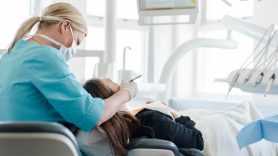How your dentist can help with oral cancer prevention
Does your dentist check for oral cancer? Our expert explains why they should and what you can expect from your dental practitioner.

The earlier cancer is detected, the better the chance of treating it successfully.
That’s why your dentist should be part of your cancer prevention team. At least twice a year, they have a good look in your mouth and have the chance to spot the first signs of oral cancer.
Dentists can also feel for signs of cancers of major salivary glands or the oropharynx.
We talked to Mark Chambers, D.M.D., chief medical director of MD Anderson’s Section of Oral Oncology. He answered some of the big questions about how your dentist can help you spot symptoms and reduce your risk for oral cancer.
What role do dentists play in cancer prevention?
Virtually all oral cancers start out as abnormalities in your mouth that can be seen by a dentist. So dentists are at the front line of early detection of oral cancer. The disease often first appears as white or red precancerous lesions inside the mouth.
Most dentists start basic oral cancer examinations at your first visit. It’s a 90-second examination that involves looking for and feeling for signs of cancer. If you want to be sure, ask your dentist if they have checked your mouth for signs of oral cancer.
This examination should be done even in younger people considered at lower risk for oral cancer. If your dentist finds oral cancer early, it significantly increases your chances of successfully treating the disease.
Dentists also are expected to talk with people at high risk for oral cancer about how to reduce their risk. They may advise you to quit tobacco or move away from unhealthy food and drink.
What exactly might a dentist see during the oral exam?
A thorough oral cancer screening exam includes more than a casual glance around the mouth. A dentist or specialist will examine and palpate the face, neck, lips, mouth, tongue, thyroid gland, salivary glands and lymph nodes for any abnormalities. If a patient has removable prosthetic teeth, they should be taken out to allow the entire mouth to be checked.
The dentist is looking for abnormalities like red patches, white patches, speckled patches and ulcers. Some dentists may use special dyes and/or lights to look for abnormal areas, especially if you have a higher risk for developing cancers.
Who is at higher risk for developing oral cancer?
Men are almost twice as likely as women to get oral cancer. People who smoke, use smokeless tobacco or drink alcohol also are at higher risk of developing oral cancers. And if you use both tobacco and alcohol, the risk is amplified.
But oral cancers in people without these risk factors are on the rise. This is because of the high rate of human papillomavirus (HPV). HPV is a sexually transmitted virus that is known to cause cancers of the oral cavity, cervix, anus, penis, vagina, and vulva.
How common is oral cancer and is it possible to reduce the risk?
Close to 53,000 Americans will be diagnosed with oral or oropharyngeal cancer this year. It will cause more than 9,750 deaths. Rates of these cancers are more than twice as high in men as in women. Cancer of the oral cavity is the eighth most common cancer among men. The average age of diagnosis is 62. About 25% of cases occur in people younger than 55.
You can reduce your risk by not using tobacco of any kind, and by not drinking alcohol. Tobacco and alcohol work together to cause damage to your mouth that can lead to cancer.
Other things that can raise your risk of developing oral and throat cancer include prolonged sun exposure, fair skin, poor oral hygiene, age, poor nutrition, HPV infection and weakened immune system.
Several of the risk factors for oral and oropharyngeal cancer can be avoided by making healthy lifestyle choices. In addition to avoiding tobacco and alcohol, eat a healthy diet and get regular exercise.
What’s the most important thing people should know on the subject of dental check-ups and cancer?
First, see your dentist twice annually as recommended by the American Dental Association. Regular dental check-ups that include an exam of the entire mouth are important in finding oral and oropharyngeal tissue changes early.
Finding cancer early, when it is small and has not spread, often allows for more treatment options.


